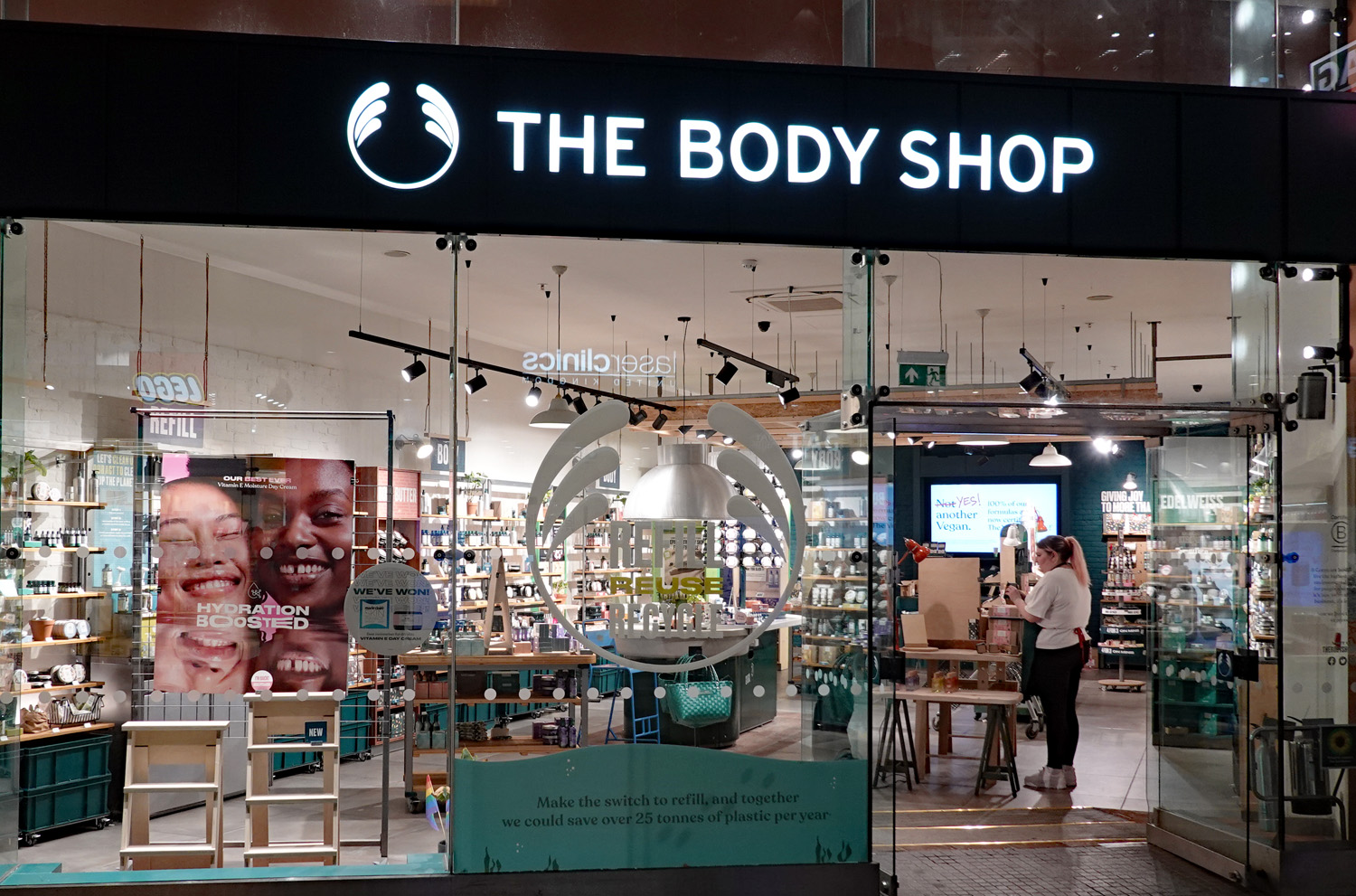 On 12 February, it was announced that The Body Shop UK was entering administration. With 199 shops across the country, if this leads to the collapse of the business, some 2000 jobs will be lost. The business has been struggling since 2020 and poor sales this last Christmas led the new owners, the pan-European alternative investment firm, Aurelius, to appoint administrators.
On 12 February, it was announced that The Body Shop UK was entering administration. With 199 shops across the country, if this leads to the collapse of the business, some 2000 jobs will be lost. The business has been struggling since 2020 and poor sales this last Christmas led the new owners, the pan-European alternative investment firm, Aurelius, to appoint administrators.
This could potentially begin an insolvency process that could result in the closure of some or all of the shops. This would spell the end of an iconic brand that, since its founding in 1976, has been associated with natural, ethically sourced and environmentally friendly products. Aurelius has already sold The Body Shop business in most of mainland Europe and in parts of Asia to an unnamed buyer. It is unclear what will happen to the approximately 2800 stores and 8000 employees in 70 countries outside the UK.
Origins of The Body Shop1
 The Body Shop was founded in 1976 and shot to fame in the 1980s. It stood for environmental awareness and an ethical approach to business. But its success had as much to do with what it sold as what it stood for. It sold natural cosmetics – Raspberry Ripple Bathing Bubbles and Camomile Shampoo – products that proved immensely popular with consumers.
The Body Shop was founded in 1976 and shot to fame in the 1980s. It stood for environmental awareness and an ethical approach to business. But its success had as much to do with what it sold as what it stood for. It sold natural cosmetics – Raspberry Ripple Bathing Bubbles and Camomile Shampoo – products that proved immensely popular with consumers.
Its profits increased from a little over £1m in 1985 (€1.7m) to approximately £65m (€77.5m) in 2012. Although profits then slipped, falling to €65.3m in 2014 and €54.8m in 2015, its profit growth in new markets over that same period was 12.4%.
Sales revenue, meanwhile, grew even more dramatically, from £4.9m in 1985 to approximately €967.2m in 2015. By 2015, Body Shop International had over 3100 stores, operating in 61 countries.
What made this success so remarkable is that The Body Shop did virtually no advertising. Its promotion stemmed largely from the activities and environmental campaigning of its founder, Anita Roddick, and the company’s uncompromising claim that it sold only ‘green’ products and conducted its business operations with high ethical standards. It actively supported green causes such as saving whales and protecting rainforests, and it refused to allow its products to be tested on animals. Perhaps most surprising in the world of big business at the time was its high-profile initiative ‘trade not aid’, whereby it claimed to pay ‘fair’ prices for its ingredients, especially those supplied by people in developing countries who were open to exploitation by large companies.
 The growth strategy of The Body Shop focused upon developing a distinctive and highly innovative product range, and at the same time identifying these products with major social issues of the day, such as the environment and animal rights.
The growth strategy of The Body Shop focused upon developing a distinctive and highly innovative product range, and at the same time identifying these products with major social issues of the day, such as the environment and animal rights.
Its initial expansion was based on a process of franchising, where individuals opened Body Shops which were then supplied by the company with its range of just 19 products. Then, in 1984 the company went public. Following its flotation, the share price rose from just 5p to a high of 370p in 1992.
In the 1990s, however, sales growth was less rapid. By 1998, earnings had collapsed by 90% and the share price fell to 117p. Shareholders forced Anita Roddick to step down as Chief Executive, but for a while she and her husband remained as co-chairs. In 2002, they stepped down as co-chairs, by which time profits had fallen to £20.4m. In 2003 she was awarded in knighthood and became Dame Anita Roddick. Sales then grew rapidly from 2004 to 2006 from €553m to €709m.
Acquisition of The Body Shop by L’Oréal
A dramatic event, however, occurred in 2006 when The Body Shop was sold to the French cosmetics giant, L’Oréal, which was 26% owned by Nestlé, The event resulted in the magazine Ethical Consumer downgrading The Body Shop’s ethical rating from 11 out of 20 to a mere 2.5 and calling for a boycott of the company. Three weeks after the sale, the daily BrandIndex recorded an 11 point drop in The Body Shop’s consumer satisfaction rating from 25 to 14.
There were several reasons for this. L’Oréal’s animal-testing policies conflicted with those of The Body Shop and L’Oréal was accused of being involved in price-fixing with other French perfume houses. L’Oréal’s part-owner, Nestlé, was also subject to various criticisms for ethical misconduct, including promoting formula milk rather than breast milk to mothers with babies in developing countries and using slave labour in cocoa farms in West Africa.
 Anita Roddick, however, believed that, by taking over The Body Shop, L’Oréal would develop a more ethical approach to business. Indeed, it did publicly recognise that it needed to develop its ethical and environmental policies.
Anita Roddick, however, believed that, by taking over The Body Shop, L’Oréal would develop a more ethical approach to business. Indeed, it did publicly recognise that it needed to develop its ethical and environmental policies.
L’Oréal adopted a new Code of Business Ethics in 2007 and gained some external accreditation for its approach to sustainability and ethics. It was ranked as one of the world’s 100 most ethical companies by Ethisphere in 2007 and, in 2016, it was again part of this list for the seventh time.
L’Oréal set itself three targets as part of its environmental strategy (2005–15), including a 50% reduction in greenhouse gas emissions, water consumption and waste per finished product unit. It made a donation of $1.2m to the US Environment Protection Agency to help bring an end to animal testing and, in March 2013, it announced a ‘total ban on the sale in Europe of any cosmetic product that was tested on animals or containing an ingredient that was tested on animals after this date.’ It also promised that ‘By 2020, we will innovate so that 100% of products have an environmental or social benefit.’
 Sadly, Anita Roddick died in 2007 and so was not able to witness these changes.
Sadly, Anita Roddick died in 2007 and so was not able to witness these changes.
L’Oréal also looked to inject greater finance into the company aimed at improving the marketing of products. In autumn 2006 a transactional website was launched and there have been larger press marketing campaigns. Profits continued to rise in 2006 and 2007, but fell back quite dramatically from €64m in 2007 to €36m in 2008 as recession hit the high streets. They fell by a further 8% in 2009, but significant growth was seen in the following three years: 2010, up 20.3% to €65.3m; 2011, up 4.3% to €68.1m; 2012, up 13.8% to €77.5m.
From L’Oréal to Natura to Aurelius to ?
 From 2013, the financial performance of The Body Shop deteriorated. Profits fell by 38% in 2016 to just €34m, with sales falling by 5%. In June 2017, L’Oréal announced that it had agreed to sell The Body Shop for €1bn (£877m) to Natura Cosmeticos, the largest Brazilian cosmetics business. Natura was awarded ‘B Corp’ status in 2014 as it met certain standards for environmental performance, accountability and transparency. In 2019, The Body Shop was separately certified as a B Corp.
From 2013, the financial performance of The Body Shop deteriorated. Profits fell by 38% in 2016 to just €34m, with sales falling by 5%. In June 2017, L’Oréal announced that it had agreed to sell The Body Shop for €1bn (£877m) to Natura Cosmeticos, the largest Brazilian cosmetics business. Natura was awarded ‘B Corp’ status in 2014 as it met certain standards for environmental performance, accountability and transparency. In 2019, The Body Shop was separately certified as a B Corp.
Initial indications for The Body Shop under its new owners seemed good, with net revenue rising by 36% in 2018 and 6.3% in 2019. 2020 saw strong growth in sales, with a rise in online sales more than offsetting the effect of store closures during the pandemic. Its market share peaked in 2020 at 1.4%. However, with the cost-of-living crisis following the pandemic and the Russian invasion of Ukraine, many consumers switched to cheaper brands and cheaper outlets, such as Boots and Superdrug, sacrificing environmental and ethical concerns in favour of value for money. As a result, The Body Shop’s market share fell, dropping to 0.8% in 2022 and not picking up in 2023.
This prompted Natura to sell the business to Aurelius. Aurelius hoped to revitalise The Body Shop by promoting its core values and through partnerships or concessions with major retailers, such as John Lewis or Next. However, as we saw above, after a poor Christmas and a weaker capital base and higher cost commitments than initially thought by Aurelius, the new owner filed to put The Body Shop into administration.
What will come of the administration process remains to be seen. Perhaps some of the more profitable stores will be saved; perhaps there will be an expansion of the online business; perhaps partnerships will be sought with major retailers. We shall see.
1 Some of this section is based on Case Study 9.3 from Economics (11th edition).
Videos
Articles
- Aurelius Acquires Iconic Global Beauty Brand and Retailer, The Body Shop
Aurelius news (14/11/23)
- Back to the future? What’s next for the Body Shop brand
Marketing Week, Niamh Carroll (14/11/23)
- The Body Shop appoints administrators for UK business
Financial Times, Laura Onita and Will Louch (13/2/24)
- The Body Shop set to appoint administrators for UK arm
Financial Times, Laura Onita (10/2/24)
- The Body Shop collapses into administration in UK
The Guardian, Sarah Butler and Rob Davies (13/2/24)
- The Body Shop UK in administration – what went wrong?
Sky News, James Sillars (13/2/24)
- Body Shop UK jobs and stores at risk in race to save firm
BBC News (13/2/24)
- From cult status to closure fears — what happened to The Body Shop?
CBC News, Natalie Stechyson (12/2/24)
- Headed for administration, why did The Body Shop fail?
Startups, Richard Parris (12/2/24)
- Comment: The Body Shop’s woes hit just as it should be at its most relevant
TheIndustry.beauty, Lauretta Roberts (13/2/24)
- The collapse of The Body Shop shows that ‘ethical’ branding is not a free pass to commercial success
The Conversation, Kokho Jason Sit (15/2/24)
Questions
- What assumptions did The Body Shop made about the ‘rational consumer’?
- How would you describe the aims of The Body Shop (a) in the early days under Anita Roddick; (b) under L’Oréal; (c) under Aurelius?
- How has The Body Shop’s economic performance been affected by its attitudes towards ethical issues?
- What has Lush done right that The Body Shop has not?
- What will the administrators seek to do?
- Find out what has happened to The Body Shop outlets in mainland Europe?
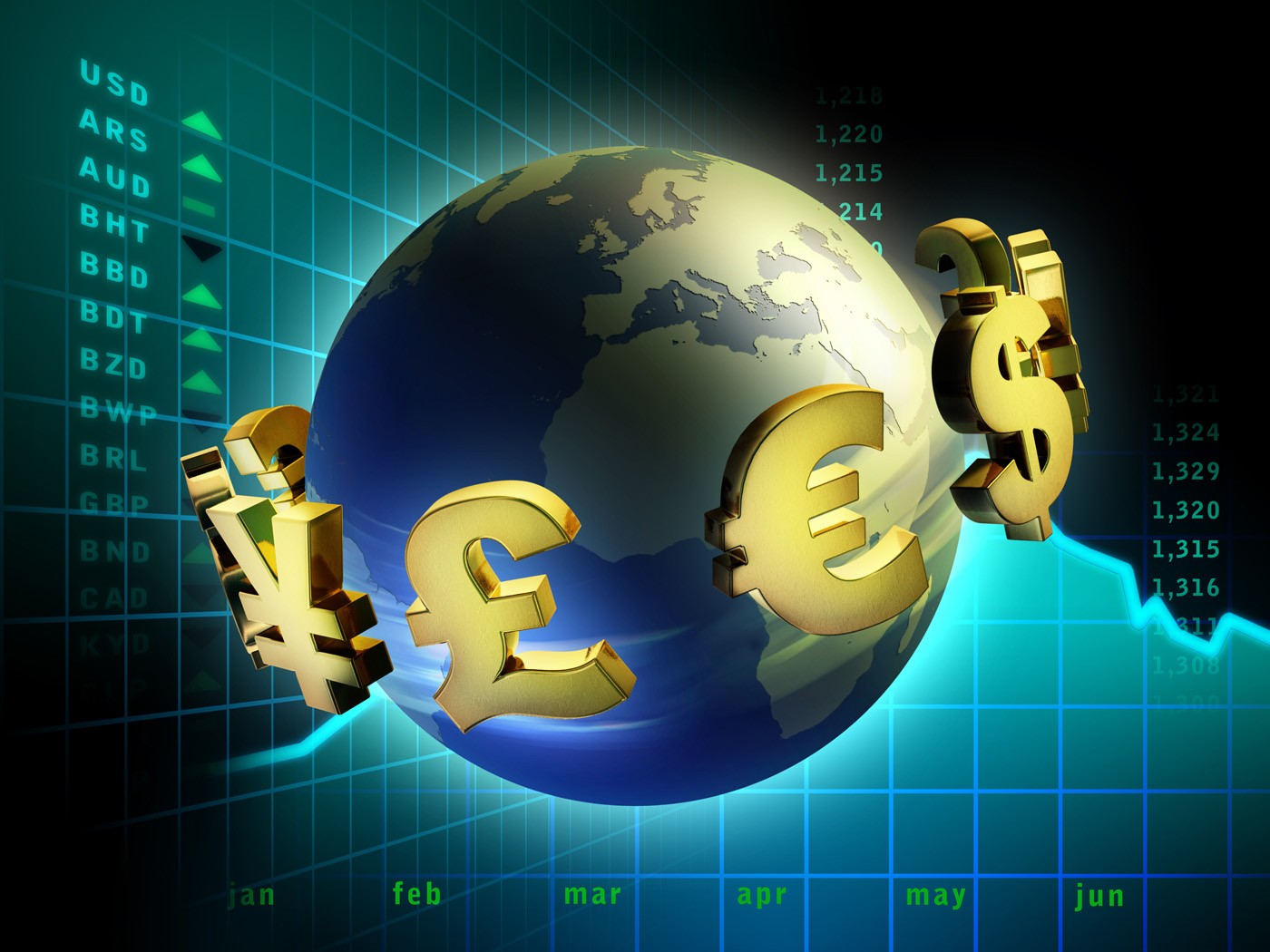 Imagine a situation where you are thinking of buying a good and so you go to an e-commerce marketplace such as Amazon, eBay, Etsy or Onbuy. How confident are you about the quality of the different brands/makes that are listed for sale on these digital platforms? How do you choose which product to buy? Is the decision strongly influenced by customer reviews and rating?
Imagine a situation where you are thinking of buying a good and so you go to an e-commerce marketplace such as Amazon, eBay, Etsy or Onbuy. How confident are you about the quality of the different brands/makes that are listed for sale on these digital platforms? How do you choose which product to buy? Is the decision strongly influenced by customer reviews and rating?
When a customer is choosing what to buy it raises an interesting question: to what extent can the true quality of the different goods/services be observed at the time of purchase? Although perfect observability is highly unlikely, the level of consumer information about a product’s true quality will vary between different types of transaction.
For example, when consumers can physically inspect and test/try a product in a shop, it can help them to make more accurate judgements about its quality and condition. This poses a problem for online sellers of high-quality versions of a good. Without the ability to inspect the item physically, consumers may be unsure about its characteristics. They may worry that the online description provided by the seller deliberately misrepresents the true quality of the item.
Consumers may have other concerns about the general reliability of online sellers. For example, in comparison to buying the product from a physical store, consumers may worry that:
- They will have to wait longer to receive the good. In many cases, when consumers purchase a product from a high-street store, they can walk away with the item and start using it straight away. When purchasing on line, they may end up waiting weeks or even longer before the product is finally delivered.
- It will be more difficult to return the product and get a refund.
- They are more likely to come across fraudulent sellers who have set-up a fake website.
This greater level of uncertainty about the true characteristics of the product and the general reliability of the seller will have a negative impact on consumers’ willingness to pay for all goods. This impact is likely to be particularly strong for high-quality versions of a product. If consumers’ willingness to pay falls below the reservation price of many sellers of high-quality goods, then the market could suffer from adverse selection and market failure.
Are there any within-market arrangements that could help deal with this issue? One possibility is for sellers to signal the quality of their products by posting consumer ratings and reviews. If consumers see that a product has many positive ratings, then this will increase their confidence in the quality of the product and so increase their willingness to pay. This could then reduce both levels of asymmetric information and the chances of adverse selection occurring in the market,
There is survey evidence that many people do read consumer reviews when choosing products on line and are heavily influenced by the ratings.
The problem of fake reviews
 However, when consumers look at these reviews can they be sure that they reflect consumers’ honest opinions and/or actual experience of using the good or service? Firms may have an incentive to manipulate and post fake reviews. For example, they could:
However, when consumers look at these reviews can they be sure that they reflect consumers’ honest opinions and/or actual experience of using the good or service? Firms may have an incentive to manipulate and post fake reviews. For example, they could:
- Deliberately fail to display negative reviews on their website while claiming that all reviews are published.
- Use internet bots to post thousands of automated reviews.
- Take positive reviews from competitors’ websites and post them on their own website.
- Pay some customers and/or employees to write and post 5-star reviews on their own website.
- Pay some customers and/or employees to write and post 1-star reviews on their competitors’ websites.
- Set up a website that they claim is independent and use it to provide positive endorsements of their own products.
If the benefits of this type of behaviour outweigh the costs, then we would expect to see fake reviews posted on websites. If their use becomes widespread, then the value of posting genuine reviews will fall. The market may then settle into what economists call a ‘pooling equilibrium’.
What evidence do we have on the posting of fake reviews? Given their nature, it is difficult to collect reliable data and there are large variations in the reported figures. One recent study found evidence of fake reviews being purchased and posted for approximately 1500 products on Amazon.
Can consumers screen reviews and identify those that are more likely to be fake? The following are some tell-tale signs.
- Products that receive a large number of very positive reviews over a short period (i.e. a few days). There are then long periods before the product receives another large number of positive reviews.
- A high percentage of 5-star reviews. Two, three and four start reviews are more likely to be genuine.
- Reviews that specifically mention a rival firm’s products.
- Reviewers who have given very high ratings to large number of different products over a short period of time.
- Reviews that include photos/videos.
Competition authorities around the world have been investigating the issue and the Competition and Markets Authority has announced plans to introduce new laws that make the purchasing and posting of fake reviews illegal.
Articles
Questions
- Outline different types of asymmetric information and explain the difference between adverse selection and moral hazard.
- Using a diagram, explain the impact of uncertainty over the quality of a good on consumers’ willingness to pay.
- Will consumers always face greater uncertainty over quality when purchasing goods on line rather than visiting the high street? Discuss your answer making reference to some specific examples.
- Using diagrams, explain how a market for high-quality versions of a good might collapse if there is asymmetric information. Using price elasticity of supply, explain the circumstances when the market is more likely to collapse.
- Discuss some of the benefits and costs for a firm of purchasing and posting fake reviews.
 When building supply and demand models, the assumption is usually made that both producers and consumers act in a ‘rational’ way to achieve the best possible outcomes. As far as producers are concerned, this would mean attempting to maximise profit. As far as consumers are concerned, it would mean attempting to achieve the highest satisfaction (utility) from their limited budget. This involves a cost–benefit calculation, where people weigh up the costs and benefits of allocating their money between different goods and services.
When building supply and demand models, the assumption is usually made that both producers and consumers act in a ‘rational’ way to achieve the best possible outcomes. As far as producers are concerned, this would mean attempting to maximise profit. As far as consumers are concerned, it would mean attempting to achieve the highest satisfaction (utility) from their limited budget. This involves a cost–benefit calculation, where people weigh up the costs and benefits of allocating their money between different goods and services.
For consumers to act rationally, the following assumptions are made:
- Consumer choices are made independently. Their individual choices and preferences are not influenced by other people’s, nor do their choices and preferences impact on other people’s choices.
- The consumer’s preferences are consistent and fixed.
- Consumers have full information about the products available and alternatives to them.
- Given the information they have and the preferences they hold, consumers will then make an optimal choice.
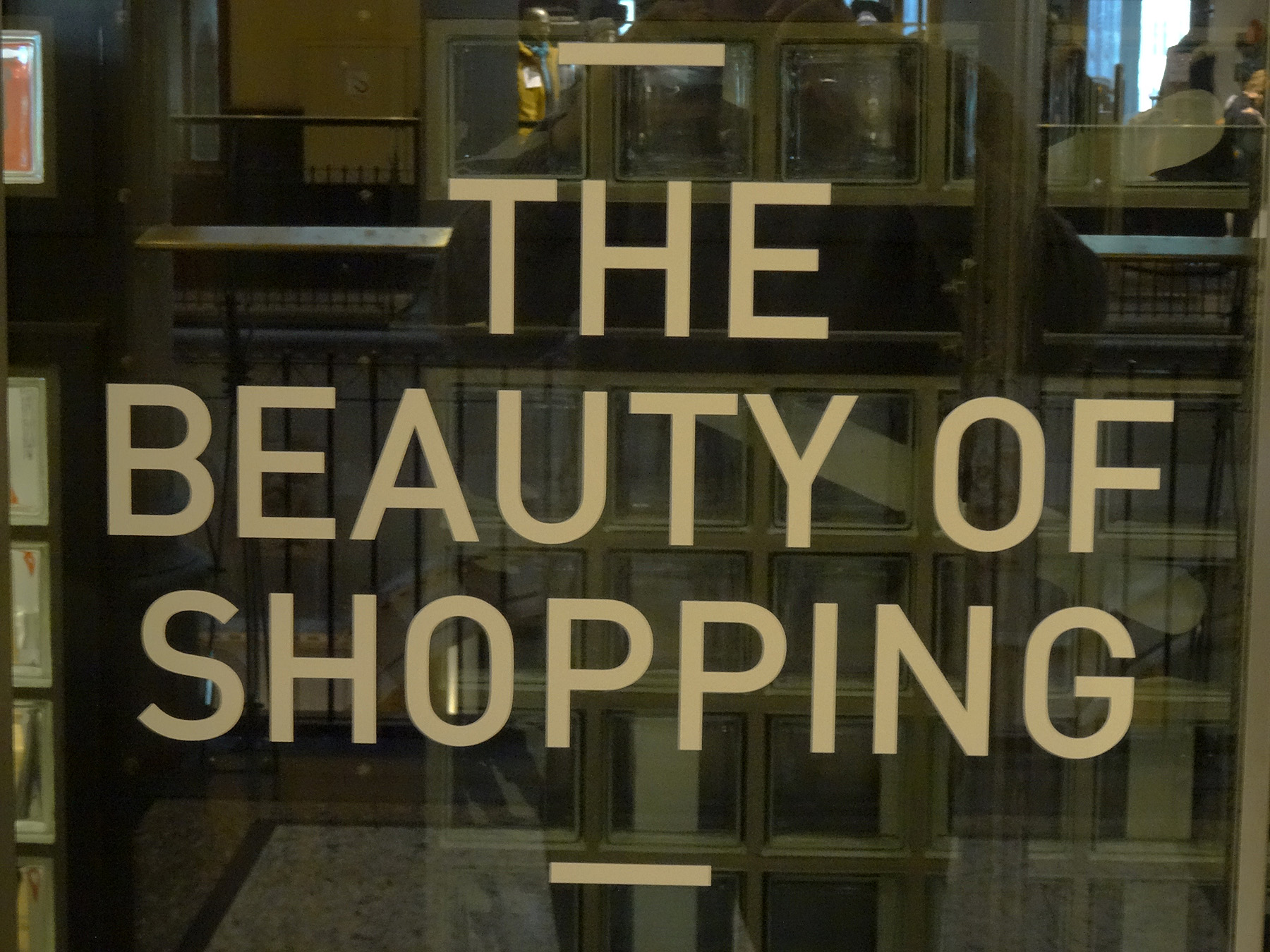 Black Friday can be seen as a perfect occasion for consumers to get their hands on a bargain. It is an opportunity to fulfil a rational need, for example if you were needing to replace a household appliance but were waiting until there was a good deal before committing to a purchase.
Black Friday can be seen as a perfect occasion for consumers to get their hands on a bargain. It is an opportunity to fulfil a rational need, for example if you were needing to replace a household appliance but were waiting until there was a good deal before committing to a purchase.
The assumption that people act rationally has been at the forefront of economic theory for decades. However, this has been questioned by the rise in behavioural economics. Rather than assuming that all individuals are ‘rational maximisers’ and conduct a cost–benefit analysis for every decision, behavioural economists mix psychology with economics by focusing on the human. As humans, we do not always behave rationally but, instead, we act under bounded rationality.
As economic agents, we make different decisions depending on our emotional state that differ from the ‘rational choice’ assumption. We are also influenced by our social networks and often make choices that provide us with immediate gratification. Given this, Black Friday can also be viewed as a great opportunity to fall prey to irrational and emotional shopping behaviours.
Black Friday originated in the USA and is the day after Thanksgiving. During this annual shopping holiday, retailers typically offer steep discounts to kick off the holiday season. The Black Friday shopping phenomenon is less than a decade old in the UK but it’s now an established part of the pre-Christmas retail calendar. Between 2010 and 2013, Black Friday gradually built up momentum in the UK. In 2014, Black Friday became the peak pre-Christmas online sales day and many online retailers haven’t looked back.
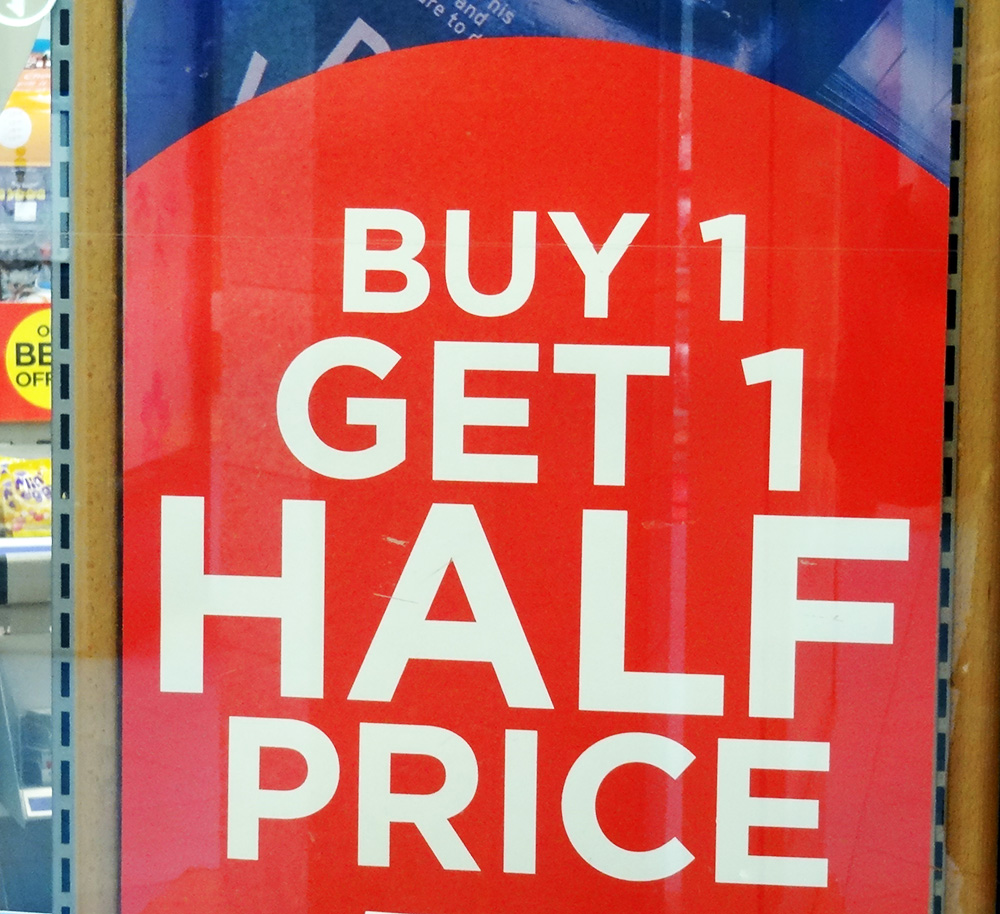 Arguably, from a behavioural economist’s perspective, the big problem with Black Friday is that all the reasons consumers possibly have to partake can be largely illusory. Consumers are bombarded with the promise of one-off deals, large discounts, scarce products, and an opportunity to get their holiday shopping done all at once. However, on Black Friday, our rational decision-making faculties are tested, just as stores are trying their hardest to maximise consumers’ mistakes.
Arguably, from a behavioural economist’s perspective, the big problem with Black Friday is that all the reasons consumers possibly have to partake can be largely illusory. Consumers are bombarded with the promise of one-off deals, large discounts, scarce products, and an opportunity to get their holiday shopping done all at once. However, on Black Friday, our rational decision-making faculties are tested, just as stores are trying their hardest to maximise consumers’ mistakes.
There are many ‘behavioural traps’ that consumers often fall into. The following two are most likely to occur on Black Friday:
- Scarcity and loss aversion. Shoppers may fear that they will miss out on the best sales deals available if they don’t buy it now. Retailers commonly spark consumers’ interest by highlighting limited stocks available for a limited time only, which raises the perceived value of these goods. This sense of scarcity can further trigger the need to buy now, increasing the ‘Fear of Missing Out’. Consumers therefore need to ask themselves if they are really missing out if they don’t buy it now? And is the discount worth spending the money today, or is there something else I should be spending it on or saving for?
- Sunk cost fallacy. Once consumers have started to invest, they often struggle to close out investments that prove unprofitable. On Black Friday, customers have already made the initial investment of getting up early, driving to the shops, finding parking and waiting in a queue, before they have purchased anything. Therefore, they will be inclined to buy more than they initially went for. It is important therefore to think about each purchase in isolation.
 This year, however, there is also the added complication of the rising cost of living. Whilst this may deter some consumers from unnecessary, impulse purchases, some consumers are using Black Friday as an opportunity to stock up on expected future purchases, hedging against likely price rises over the coming months.
This year, however, there is also the added complication of the rising cost of living. Whilst this may deter some consumers from unnecessary, impulse purchases, some consumers are using Black Friday as an opportunity to stock up on expected future purchases, hedging against likely price rises over the coming months.
It is thought that more consumers will be looking for a combination of high quality but low price to make sure their purchases are affordable and can last for a long time. According to PwC, many consumers have closely monitored their favourite brands in anticipation that big-ticket electronics, more pricey winter wear or Christmas stocking fillers will be discounted. Consumers are also in search of bargains more than ever given rising inflation. This would suggest a shift in attitude, meaning consumers will be more aware of what they cannot afford rather than giving in to emotional temptation brought on by Black Friday.
Retailers are fully aware of the cognitive biases that surround Black Friday and take full advantage of them. ‘Cyber Monday’ follows right after Black Friday, giving retailers an extra opportunity for them to keep those ‘urgent’ or ‘unmissable’ sales going and increase their revenues.
 Black Friday is one of the biggest shopping days of the year. However, the way retailers approach it is growing increasingly mixed. Stores such as Amazon, Argos, Currys and John Lewis have started offering Black Friday deals much earlier in the month, leading some to refer to the event as ‘Black November’. Other stores, such as M&S and Next, didn’t take part at all this year.
Black Friday is one of the biggest shopping days of the year. However, the way retailers approach it is growing increasingly mixed. Stores such as Amazon, Argos, Currys and John Lewis have started offering Black Friday deals much earlier in the month, leading some to refer to the event as ‘Black November’. Other stores, such as M&S and Next, didn’t take part at all this year.
Ultimately, Consumers can use insights from behavioural economics to empower them to make more rational decisions in such circumstances: ones that better align with their individual budgets. Nevertheless, the Black Friday sales mania can trigger our deepest emotional and cognitive responses that lead to unnecessary spending.
Articles
Video
Questions
- Discuss what is meant by the term ‘rational consumer’. Is it a useful generalisation about the way consumers behave?
- Discuss what is meant by the term ‘rational producer’. Is it a useful generalisation about the way firms behave?
- What is cost–benefit analysis? What is the procedure used in conducting a cost–benefit analysis?
- In addition to scarcity and loss aversion and the sunk cost fallacy, are there any other reasons why consumers may not always act rationally?
- Are people likely to be more ‘rational’ about online Black Friday purchases than in-store ones? Explain.
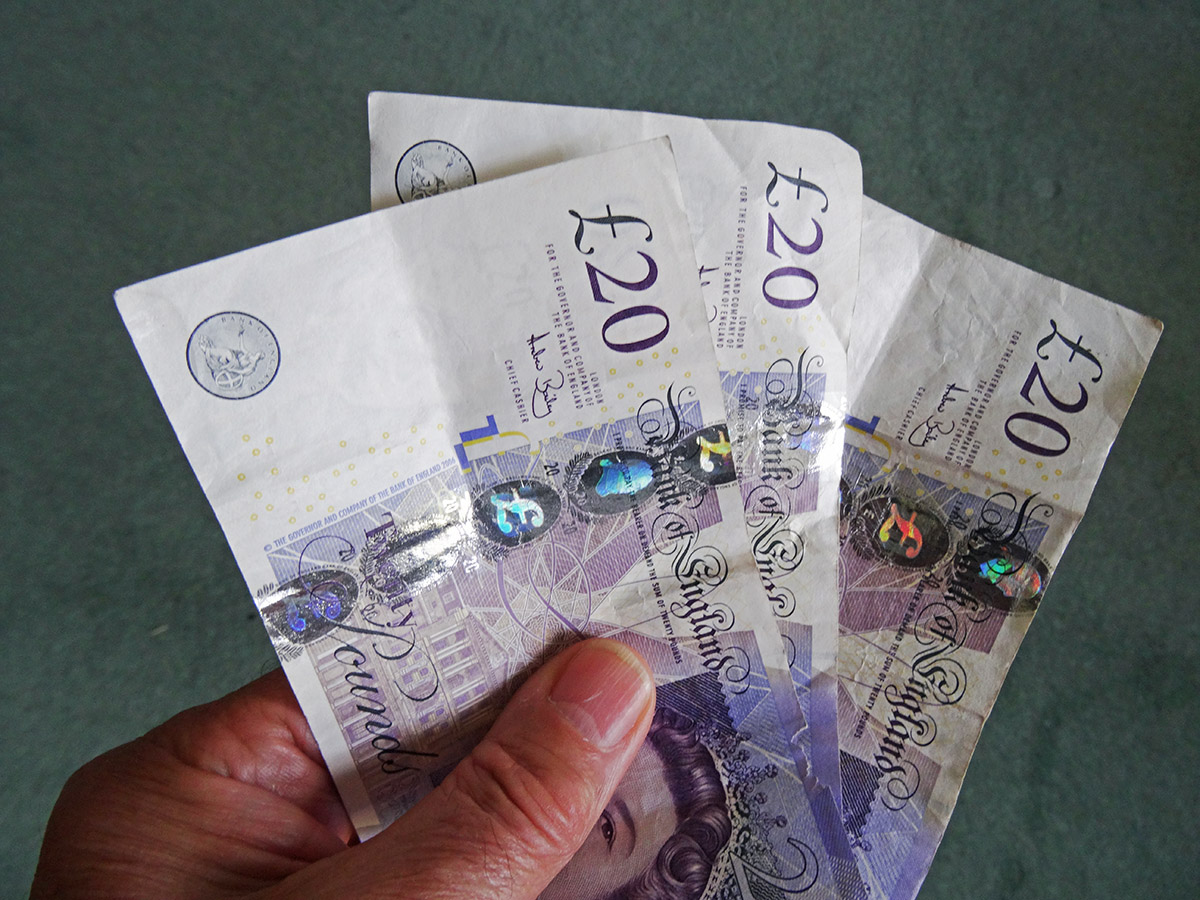 How to get the most from your money? This is the question posed by the linked article below. It’s a topic we’ve looked at in previous posts, such as Studies show that money can buy happiness (but only if you spend on experiences), Happiness economics and Peak stuff. This article takes the arguments further.
How to get the most from your money? This is the question posed by the linked article below. It’s a topic we’ve looked at in previous posts, such as Studies show that money can buy happiness (but only if you spend on experiences), Happiness economics and Peak stuff. This article takes the arguments further.
It suggests that, up to a certain level of income, there is a roughly linear relationship between money and life satisfaction. As poor people have more to spend, so they can begin to escape poverty and the negative features of financial insecurity and a lack of basic necessities, such as food and shelter. They also gain a greater freedom to choose what and when to buy. Beyond a certain level, however, the rate of increase in life satisfaction tends to decline, as does the specific pleasure from additional individual purchases. In economists’ language, the marginal utility of income diminishes.
But the article goes further than this. It suggests that satisfaction or happiness is of two broad types. The first is the general sense of well-being that people get from their life. This tends to be relatively stable for any given person, but will tend to increase as people have more money to spend or have more fulfilling jobs. Of course, there may well be a trade-off between income and job satisfaction. Some people may prefer to take a cut in pay for a more fulfilling job.
 The second is the satisfaction or happiness you get from specific experiences. This tends to fluctuate on a day-to-day basis, depending on what you are doing. Here, what you purchase and the use you make of the purchases is a key component.
The second is the satisfaction or happiness you get from specific experiences. This tends to fluctuate on a day-to-day basis, depending on what you are doing. Here, what you purchase and the use you make of the purchases is a key component.
So what lessons are there for earning and spending money wisely? To start with, it is important to get a good work-life balance. It may be worth trading income for job satisfaction. Here the focus should be on long-term fulfilment, rather than on the short-term happiness from more ‘stuff’. Then it is important to spend money wisely. Here the author identifies three lessons:
The first is to consider buying time. Time-saving purchases, such as dishwashers can help. So too can ‘outsourcing’ activities, such as cleaning, laundry, cooking, DIY or child care, if they give you more time to do other more fulfilling things (but not if you love doing them!).
 The second is to spend more money on experiences (as we saw in the post Studies show that money can buy happiness (but only if you spend on experiences). A better TV or car may seem like a wiser investment than more dinners out, holidays or going to concerts. But we quickly adapt to new upgraded ‘stuff’, thereby eliminating any additional satisfaction. Experiences, however, tend to linger in the memory. As Tom Gilovich, a psychology professor at Cornell University, is quoted by the article as saying:
The second is to spend more money on experiences (as we saw in the post Studies show that money can buy happiness (but only if you spend on experiences). A better TV or car may seem like a wiser investment than more dinners out, holidays or going to concerts. But we quickly adapt to new upgraded ‘stuff’, thereby eliminating any additional satisfaction. Experiences, however, tend to linger in the memory. As Tom Gilovich, a psychology professor at Cornell University, is quoted by the article as saying:
Even though, in a material sense, they [experiences] come and go, they live on in the stories we tell, the relationships we cement, and ultimately in the sense of who we are.
Choosing a more fulfilling but less well-paid job is a form of spending money on experiences.
The third is to give some of your money away, whether to charity or to helping friends or relatives. As Gilovich says:
It’s hard to find a more charming finding than that by giving away money, you not only make someone else happier, you make yourself happier.
Article
Questions
- What is meant by ‘diminishing marginal utility of income’? Is the concept consistent with the arguments in the article?
- In what sense may it be rational to choose a lower-paid job?
- Is ‘happiness’ the same as ‘utility’ as the concept is used by economists?
- Does the concept of ‘peak stuff’ apply to all physical products? Explain your answer.
- If giving money away makes a person happy, is it truly altruistic for that person to do so? Explain.
 Economists are often criticised for making inaccurate forecasts and for making false assumptions. Their analysis is frequently dismissed by politicians when it contradicts their own views.
Economists are often criticised for making inaccurate forecasts and for making false assumptions. Their analysis is frequently dismissed by politicians when it contradicts their own views.
But is this fair? Have economists responded to the realities of the global economy and to the behaviour of people, firms, institutions and government as they respond to economic circumstances? The answer is a qualified yes.
Behavioural economics is increasingly challenging the simple assumption that people are ‘rational’, in the sense that they maximise their self interest by weighing up the marginal costs and benefits of alternatives open to them. And macroeconomic models are evolving to take account of a range of drivers of global growth and the business cycle.
 The linked article and podcast below look at the views of 2019 Nobel Prize-winning economist Esther Duflo. She has challenged some of the traditional assumptions of economics about the nature of rationality and what motivates people. But her work is still very much in the tradition of economists. She examines evidence and sees how people respond to incentives and then derives policy implications from the analysis.
The linked article and podcast below look at the views of 2019 Nobel Prize-winning economist Esther Duflo. She has challenged some of the traditional assumptions of economics about the nature of rationality and what motivates people. But her work is still very much in the tradition of economists. She examines evidence and sees how people respond to incentives and then derives policy implications from the analysis.
Take the case of the mobility of labour. She examines why people who lose their jobs may not always move to a new one if it’s in a different town. Partly this is for financial reasons – moving is costly and housing may be more expensive where the new job is located. Partly, however, it is for reasons of identity. Many people are attached to where they currently live. They may be reluctant to leave family and friends and familiar surroundings and hope that a new job will turn up – even if it means a cut in wages. This is not irrational; it just means that people are driven by more than simply wages.
Duflo is doing what economists typically do – examining behaviour in the light of evidence. In her case, she is revisiting the concept of rationality to take account of evidence on what motivates people and the way they behave.
 In the light of workers’ motivation, she considers the implications for the gains from trade. Is free trade policy necessarily desirable if people lose their jobs because of cheap imports from China and other developing countries where labour costs are low?
In the light of workers’ motivation, she considers the implications for the gains from trade. Is free trade policy necessarily desirable if people lose their jobs because of cheap imports from China and other developing countries where labour costs are low?
The answer is not a clear yes or no, as import-competing industries are only part of the story. If protectionist policies are pursued, other countries may retaliate with protectionist policies themselves. In such cases, people working in the export sector may lose their jobs.
She also looks at how people may respond to a rise or cut in tax rates. Again the answer is not clear cut and an examination of empirical evidence is necessary to devise appropriate policy. Not only is there an income and substitution effect from tax changes, but people are motivated to work by factors other than take-home pay. Likewise, firms are encouraged to invest by factors other than the simple post-tax profitability of investment.
Podcast
Article
Questions
- In traditional ‘neoclassical’ economics, what is meant by ‘rationality’ in terms of (a) consumer behaviour; (b) producer behaviour?
- How might the concept of rationality be expanded to take into account a whole range of factors other than the direct costs and benefits of a decision?
- What is meant by bounded rationality?
- What would be the effect on workers’ willingness to work more or fewer hours as a result of a cut in the marginal income tax rate if (a) the income effect was greater than the substitution effect; (b) the substitution effect was greater than the income effect? Would your answers to (a) and (b) be the opposite in the case of a rise in the marginal income tax rate?
- Give some arguments that you consider to be legitimate for imposing controls on imports in (a) the short run; (b) the long run. How might you counter these arguments from a free-trade perspective?
 On 12 February, it was announced that The Body Shop UK was entering administration. With 199 shops across the country, if this leads to the collapse of the business, some 2000 jobs will be lost. The business has been struggling since 2020 and poor sales this last Christmas led the new owners, the pan-European alternative investment firm, Aurelius, to appoint administrators.
On 12 February, it was announced that The Body Shop UK was entering administration. With 199 shops across the country, if this leads to the collapse of the business, some 2000 jobs will be lost. The business has been struggling since 2020 and poor sales this last Christmas led the new owners, the pan-European alternative investment firm, Aurelius, to appoint administrators. The Body Shop was founded in 1976 and shot to fame in the 1980s. It stood for environmental awareness and an ethical approach to business. But its success had as much to do with what it sold as what it stood for. It sold natural cosmetics – Raspberry Ripple Bathing Bubbles and Camomile Shampoo – products that proved immensely popular with consumers.
The Body Shop was founded in 1976 and shot to fame in the 1980s. It stood for environmental awareness and an ethical approach to business. But its success had as much to do with what it sold as what it stood for. It sold natural cosmetics – Raspberry Ripple Bathing Bubbles and Camomile Shampoo – products that proved immensely popular with consumers. The growth strategy of The Body Shop focused upon developing a distinctive and highly innovative product range, and at the same time identifying these products with major social issues of the day, such as the environment and animal rights.
The growth strategy of The Body Shop focused upon developing a distinctive and highly innovative product range, and at the same time identifying these products with major social issues of the day, such as the environment and animal rights. Anita Roddick, however, believed that, by taking over The Body Shop, L’Oréal would develop a more ethical approach to business. Indeed, it did publicly recognise that it needed to develop its ethical and environmental policies.
Anita Roddick, however, believed that, by taking over The Body Shop, L’Oréal would develop a more ethical approach to business. Indeed, it did publicly recognise that it needed to develop its ethical and environmental policies. Sadly, Anita Roddick died in 2007 and so was not able to witness these changes.
Sadly, Anita Roddick died in 2007 and so was not able to witness these changes. From 2013, the financial performance of The Body Shop deteriorated. Profits fell by 38% in 2016 to just €34m, with sales falling by 5%. In June 2017, L’Oréal announced that it had agreed to sell The Body Shop for €1bn (£877m) to Natura Cosmeticos, the largest Brazilian cosmetics business. Natura was awarded ‘B Corp’ status in 2014 as it met certain standards for environmental performance, accountability and transparency. In 2019, The Body Shop was separately certified as a B Corp.
From 2013, the financial performance of The Body Shop deteriorated. Profits fell by 38% in 2016 to just €34m, with sales falling by 5%. In June 2017, L’Oréal announced that it had agreed to sell The Body Shop for €1bn (£877m) to Natura Cosmeticos, the largest Brazilian cosmetics business. Natura was awarded ‘B Corp’ status in 2014 as it met certain standards for environmental performance, accountability and transparency. In 2019, The Body Shop was separately certified as a B Corp. The Body Shop begins filing for administration
The Body Shop begins filing for administration Hundreds of jobs at risk as The Body Shop goes into administration
Hundreds of jobs at risk as The Body Shop goes into administration The body shop’s UK business in peril
The body shop’s UK business in peril The Body Shop UK Enters Administration
The Body Shop UK Enters Administration Imagine a situation where you are thinking of buying a good and so you go to an e-commerce marketplace such as Amazon, eBay, Etsy or Onbuy. How confident are you about the quality of the different brands/makes that are listed for sale on these digital platforms? How do you choose which product to buy? Is the decision strongly influenced by customer reviews and rating?
Imagine a situation where you are thinking of buying a good and so you go to an e-commerce marketplace such as Amazon, eBay, Etsy or Onbuy. How confident are you about the quality of the different brands/makes that are listed for sale on these digital platforms? How do you choose which product to buy? Is the decision strongly influenced by customer reviews and rating? However, when consumers look at these reviews can they be sure that they reflect consumers’ honest opinions and/or actual experience of using the good or service? Firms may have an incentive to manipulate and post fake reviews. For example, they could:
However, when consumers look at these reviews can they be sure that they reflect consumers’ honest opinions and/or actual experience of using the good or service? Firms may have an incentive to manipulate and post fake reviews. For example, they could: When building supply and demand models, the assumption is usually made that both producers and consumers act in a ‘rational’ way to achieve the best possible outcomes. As far as producers are concerned, this would mean attempting to maximise profit. As far as consumers are concerned, it would mean attempting to achieve the highest satisfaction (utility) from their limited budget. This involves a cost–benefit calculation, where people weigh up the costs and benefits of allocating their money between different goods and services.
When building supply and demand models, the assumption is usually made that both producers and consumers act in a ‘rational’ way to achieve the best possible outcomes. As far as producers are concerned, this would mean attempting to maximise profit. As far as consumers are concerned, it would mean attempting to achieve the highest satisfaction (utility) from their limited budget. This involves a cost–benefit calculation, where people weigh up the costs and benefits of allocating their money between different goods and services. Black Friday can be seen as a perfect occasion for consumers to get their hands on a bargain. It is an opportunity to fulfil a rational need, for example if you were needing to replace a household appliance but were waiting until there was a good deal before committing to a purchase.
Black Friday can be seen as a perfect occasion for consumers to get their hands on a bargain. It is an opportunity to fulfil a rational need, for example if you were needing to replace a household appliance but were waiting until there was a good deal before committing to a purchase.  Arguably, from a behavioural economist’s perspective, the big problem with Black Friday is that all the reasons consumers possibly have to partake can be largely illusory. Consumers are bombarded with the promise of one-off deals, large discounts, scarce products, and an opportunity to get their holiday shopping done all at once. However, on Black Friday, our rational decision-making faculties are tested, just as stores are trying their hardest to maximise consumers’ mistakes.
Arguably, from a behavioural economist’s perspective, the big problem with Black Friday is that all the reasons consumers possibly have to partake can be largely illusory. Consumers are bombarded with the promise of one-off deals, large discounts, scarce products, and an opportunity to get their holiday shopping done all at once. However, on Black Friday, our rational decision-making faculties are tested, just as stores are trying their hardest to maximise consumers’ mistakes. This year, however, there is also the added complication of the rising cost of living. Whilst this may deter some consumers from unnecessary, impulse purchases, some consumers are using Black Friday as an opportunity to stock up on expected future purchases, hedging against likely price rises over the coming months.
This year, however, there is also the added complication of the rising cost of living. Whilst this may deter some consumers from unnecessary, impulse purchases, some consumers are using Black Friday as an opportunity to stock up on expected future purchases, hedging against likely price rises over the coming months. Black Friday is one of the biggest shopping days of the year. However, the way retailers approach it is growing increasingly mixed. Stores such as Amazon, Argos, Currys and John Lewis have started offering Black Friday deals much earlier in the month, leading some to refer to the event as ‘Black November’. Other stores, such as M&S and Next, didn’t take part at all this year.
Black Friday is one of the biggest shopping days of the year. However, the way retailers approach it is growing increasingly mixed. Stores such as Amazon, Argos, Currys and John Lewis have started offering Black Friday deals much earlier in the month, leading some to refer to the event as ‘Black November’. Other stores, such as M&S and Next, didn’t take part at all this year. How to get the most from your money? This is the question posed by the linked article below. It’s a topic we’ve looked at in previous posts, such as
How to get the most from your money? This is the question posed by the linked article below. It’s a topic we’ve looked at in previous posts, such as  The second is the satisfaction or happiness you get from specific experiences. This tends to fluctuate on a day-to-day basis, depending on what you are doing. Here, what you purchase and the use you make of the purchases is a key component.
The second is the satisfaction or happiness you get from specific experiences. This tends to fluctuate on a day-to-day basis, depending on what you are doing. Here, what you purchase and the use you make of the purchases is a key component. The second is to spend more money on experiences (as we saw in the post
The second is to spend more money on experiences (as we saw in the post  Economists are often criticised for making inaccurate forecasts and for making false assumptions. Their analysis is frequently dismissed by politicians when it contradicts their own views.
Economists are often criticised for making inaccurate forecasts and for making false assumptions. Their analysis is frequently dismissed by politicians when it contradicts their own views.  The linked article and podcast below look at the views of 2019
The linked article and podcast below look at the views of 2019  In the light of workers’ motivation, she considers the implications for the gains from trade. Is free trade policy necessarily desirable if people lose their jobs because of cheap imports from China and other developing countries where labour costs are low?
In the light of workers’ motivation, she considers the implications for the gains from trade. Is free trade policy necessarily desirable if people lose their jobs because of cheap imports from China and other developing countries where labour costs are low?